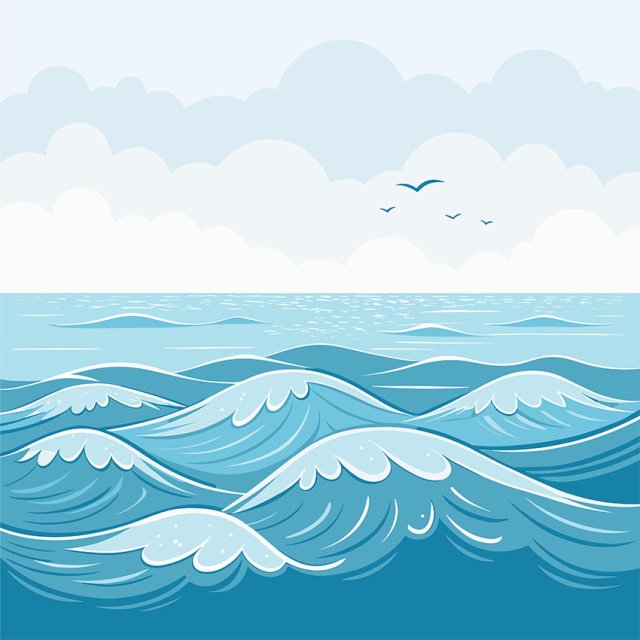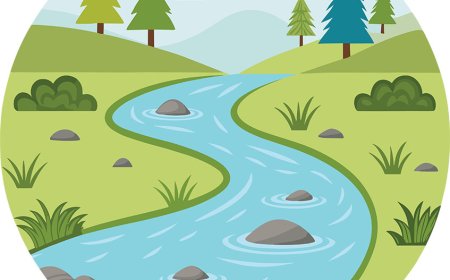Ocean Currents Facts for Students | Water and Ocean Guide
Learn what ocean currents are how they move water around the world why they are important for climate weather and sea life in this student guide

🌟 Introduction
Ocean currents are large streams of moving water that flow through the world's oceans. They act like massive rivers within the sea, carrying warm and cold water across great distances. Currents are powered by winds, tides, Earth's rotation, and differences in water temperature and salt levels. These movements are vital for life on Earth because they help shape climate, move nutrients, and support marine animals. From the powerful Gulf Stream in the Atlantic Ocean to the deep "global conveyor belt" that circulates water around the planet, ocean currents keep Earth's oceans-and our weather-alive and in balance.
🔍 Understanding Ocean Currents
Ocean currents can be grouped into two main types:
-
Surface Currents - These flow in the upper part of the ocean and are driven mostly by winds. They can move warm water from the equator toward the poles.
-
Deep Currents - These flow far below the surface, caused by differences in water density, temperature, and salt. They move slowly but carry enormous amounts of water.
Together, surface and deep currents create a worldwide circulation system known as the global conveyor belt, which connects all of Earth's oceans.
🌍 Why Is It Important?
Ocean currents are important because they:
-
Regulate climate, moving warm water to colder regions and cold water to warmer ones.
-
Support marine life, distributing oxygen and nutrients throughout the ocean.
-
Affect weather patterns, influencing rainfall, storms, and even droughts.
-
Help transportation, since ships have used currents for faster travel for centuries.
-
Connect ecosystems, linking distant oceans and spreading species across the globe.
🧪 Real-Life Connections
-
The Gulf Stream helps keep Europe warmer than other regions at the same latitude.
-
Fishermen depend on nutrient-rich cold currents, like the Peru Current, for abundant fish.
-
Climate events such as El Niño happen when currents in the Pacific Ocean change direction.
-
Sailors and explorers, like Christopher Columbus, used ocean currents to travel faster.
-
Today, scientists study currents to predict weather, track pollution, and understand climate change.
✨ Interesting Facts
-
Some currents, like the Antarctic Circumpolar Current, circle the globe nonstop.
-
Deep currents can take 1,000 years to complete a full trip around the Earth.
-
Ocean currents carry more water than all the world's rivers combined.
-
Without currents, some coastal regions would be too hot or too cold for people to live.
📌 Key Takeaways
-
Ocean currents are giant rivers of moving water in the ocean.
-
They regulate climate, support sea life, and influence weather.
-
The global conveyor belt connects all of Earth's oceans.
🐾 Kid-Friendly Summary
Ocean currents are like highways in the ocean, moving warm and cold water all around the world. They keep Earth's climate steady, feed fish with nutrients, and even help ships travel.
📚 Vocabulary Words
-
Ocean Current - A continuous movement of ocean water.
-
Surface Current - A current near the ocean's surface, driven by wind.
-
Deep Current - A current deep in the ocean, caused by water density and temperature.
-
Global Conveyor Belt - The worldwide system of connected currents.
-
Gulf Stream - A powerful warm ocean current in the Atlantic Ocean.
-
El Niño - A climate event caused by changes in Pacific Ocean currents.
-
Upwelling - When deep, nutrient-rich water rises to the surface.
-
Circulation - The movement of water around Earth's oceans.
Interactive Quiz: Ocean Currents
Instructions: Choose the best answer. Answers are listed at the end.
-
What are ocean currents?
A) Rivers of moving water in the ocean
B) Small puddles
C) Rain clouds
D) Waves crashing on shore -
What mainly drives surface currents?
A) Wind
B) Earthquakes
C) Volcanoes
D) Rain -
What is the global conveyor belt?
A) A factory machine
B) A worldwide system of ocean currents
C) A mountain range
D) A type of fish -
Which ocean current keeps Europe warmer?
A) Gulf Stream
B) Antarctic Current
C) Pacific Drift
D) Peru Current -
Why are ocean currents important for marine life?
A) They provide oxygen and nutrients
B) They create deserts
C) They form mountains
D) They make water salty




















































